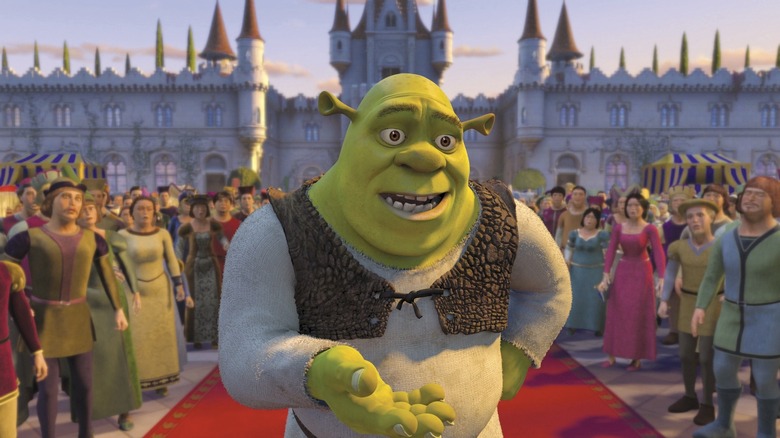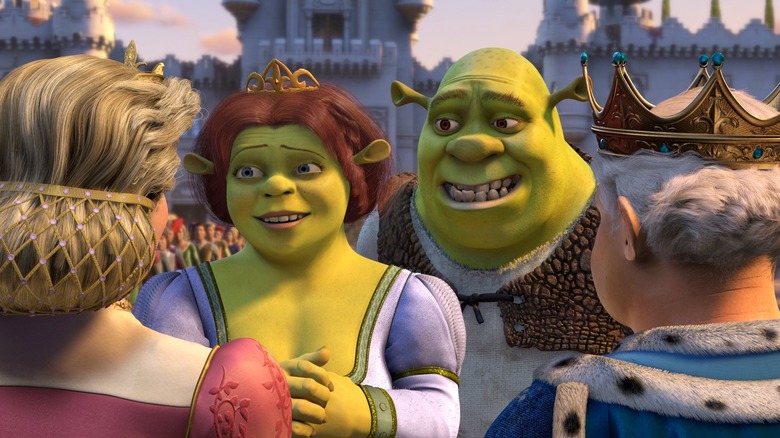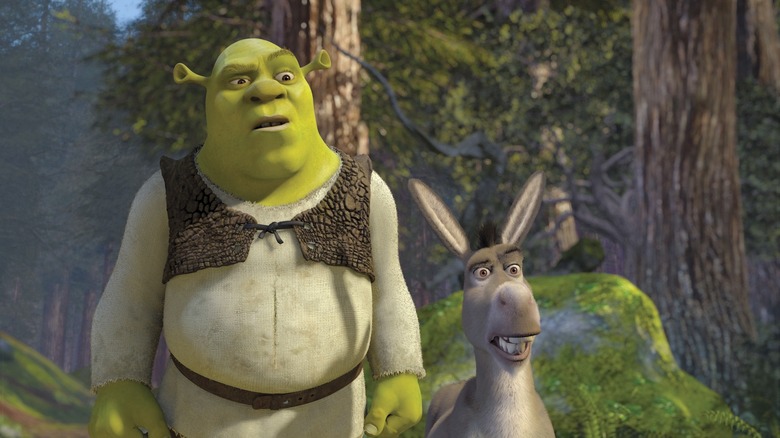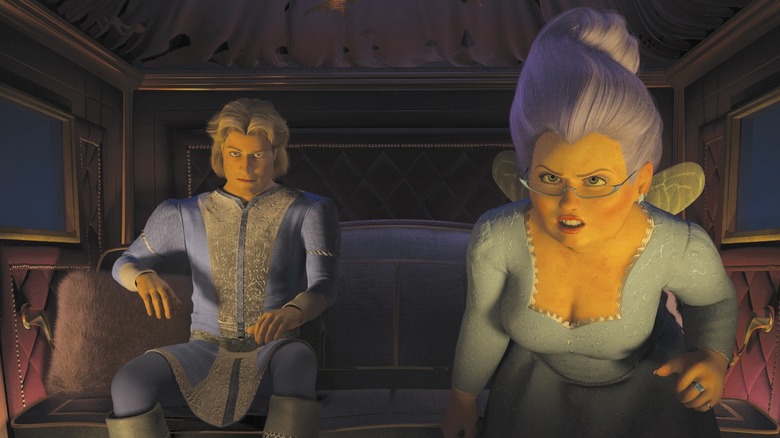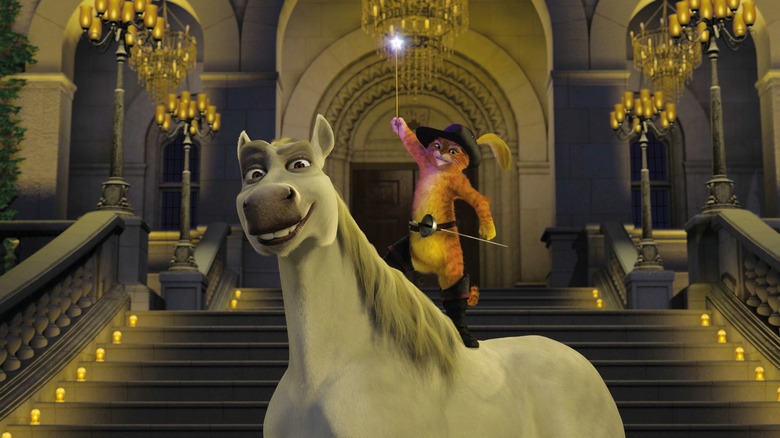20 Years Ago, Shrek 2 Broke The Mold At The Box Office
(Welcome to Tales from the Box Office, our column that examines box office miracles, disasters, and everything in between, as well as what we can learn from them.)
"Shrek" was a very important movie in animation history. It provided DreamWorks with its first true breakthrough hit, taking in $492 million in 2001. It ensured that Disney would have meaningful competition in the animation space for years to come, which has only been furthered in recent years with the dominance of Illumination in the marketplace. For DreamWorks though, it birthed what would become the studio's flagship franchise, one that has generated more than $3 billion since its inception. That franchise's biggest moment came in 2004 when "Shrek 2" hit theaters.
The animation house founded by former Disney executive Jeffrey Katzenberg hit a home run by pairing Mike Myers and Eddie Murphy as Shrek and Donkey in the first film, in no small part thanks to the stellar supporting cast. For the sequel, Myers, Murphy, and Cameron Diaz's Fiona would all return in a follow-up that proved bigger can also be better. Two decades later, it's oft-regarded as one of the best sequels ever made — particularly by those who grew up with it — right alongside the likes of "The Dark Knight" and "Aliens." And it's a movie that has earned its place atop that very prestigious hill.
In this week's Tales from the Box Office, we're looking back at "Shrek 2" in honor of the film's 20th anniversary re-release in theaters this weekend. We'll look at how the first movie set up a bigger (more expensive) sequel, how the perfect cast came together, what happened when the movie hit theaters, the legacy it left behind, and what we can learn from it all these years later. Let's dig in, shall we?
The movie: Shrek 2
"Shrek 2" was guaranteed when the first film became one of the biggest hits of 2001. The sequel was directed by a trio of filmmakers; Andrew Adamson, Kelly Asbury, and Conrad Vernon. But it was very much Katzenberg steering the ship from the top of DreamWorks. For better or worse, Katzenberg was one of the people chiefly responsible for getting big-name actors to do voices in animated films, such as Robin Williams as Genie in "Aladdin." Hence, hiring Myers, Murphy, and Diaz for the first film.
When it came time for the core trio to sign on for the sequel, they had a lot of power and managed to negotiate huge paydays in the $10 million range. Beyond that, the surrounding cast for the sequel included Antonio Banderas as the swashbuckling Puss in Boots, Rupert Everett as Prince Charming, and the legendary Julie Andrews as the Queen. Speaking to Indie London shortly after the film's release, Katzenberg explained that it was the studio's dream cast.
"I guess we were under the radar when we start these things, they're so many years in advance. So each of the people here were our dreams. We were actually blessed, because it's that rare thing, to actually get who you hope for. It doesn't matter who you are — whether a producer, or director — it's so rare that their schedule and your ambition, and what they want to do in their career, actually comes together. It sort of happens once in a lifetime."
The sequel sees Shrek and Fiona living happily together until they have to take a trip to meet Fiona's human parents who are both human and royalty. They are understandably surprised to see Fiona is not only still an ogre herself, but that she's decided to marry one. Shrek, feeling guilty, gets conned by the Fairy Godmother (Jennifer Saunders) into taking a potion that turns him into a human. Naturally, things go south and it becomes a big quest to battle the Fairy Godmother before Shrek loses Fiona forever.
A surprisingly short journey for Shrek and Donkey
It's important to point out that Disney was still the dominant force in animation at this time, with Pixar shouldering the lion's share of the load. For as much as "Shrek" was a big hit, it still trailed "Monsters Inc." in 2001. It's also important to point out that Katzenberg was fired from Disney and pretty much put together DreamWorks to seek revenge on his former employer. That's why "Shrek 2" is such an important movie in this studio's history. It was the first time that DreamWorks managed to best the House of Mouse at the box office — and it did so with a surprisingly short, kind of simple movie.
"Shrek 2" clocks in at less than 90 minutes not counting credits. It also maintains many of the same themes as the first film. In the end, it's a lot more of the same, which is part of what appealed to audiences so much. But that doesn't mean the filmmakers coasted through the process. There was a tremendous amount of surprising thought put into the film. Production designer Guillaume Aretos explained in a 2004 interview with AWN that they were inspired by 19th-century illustrators like Gustave Doré, among others.
"There are a lot of medieval paintings and illustrations that we used quite a bit also. Other than that there are my own influences, which are classical paintings from the 15th and 16th centuries, but those are not as direct. In fact, nothing was absolutely direct. The design of 'Shrek' is always a twist on reality anyway, so we tried to [pack] as much detail and interest as we could into the imagery."
Armed with a visually impressive film filled with influences that may be lost on the target audience, namely children, DreamWorks completed the film in time to ensure that it would hit theaters less than three years after the first "Shrek" put the studio on the map. They couldn't have possibly been prepared for what came next.
The financial journey
Before "Shrek 2" hit theaters In April 2004, it was selected to compete for the Palme d'Or at the 2004 Cannes Film Festival. That spoke volumes about the quality ahead of its release. The buzz was so strong that the studio actually ended up bumping up the release by two days, releasing it mid-week on May 19. It also set a new record, becoming the first film to play on over 4,000 screens in North America, beating the previous record-holder "X2: X-Men United," which became a huge hit itself in 2003. To say the buzz was palpable would be an understatement.
The two-day head start only supercharged the gigantic opening weekend for "Shrek 2." Hollywood steered clear of the sequel and, in the end, that proved to be a very wise choice. The follow-up pulled in an astounding $108 million in its first frame. Mind you, this was just a couple of years after Sam Raimi's "Spider-Man" became the first movie ever to make more than $100 million in a single weekend. So this was still exceptionally rare air.
Things continued to go well in the film's second weekend, as "The Day After Tomorrow," "Raising Helen," and "Soul Plane" all proved to be no match for Shrek and Donkey. The sequel held onto the top spot easily with a $72.1 million haul, dropping just 33% compared to its first weekend. DreamWorks had a runaway hit on its hands, even with the film's much bigger $150 million budget.
"Shrek 2" finished its record-breaking run $441.4 million domestically to go with a stellar $487.5 million internationally for a grand total of $928.9 million globally in its original run. That was, at the time, enough to make it the highest-grossing animated feature of all time. It was also the top-grossing movie globally of 2004 overall. To top it all off, the film also went on to become the top-selling DVD of the year. It was DreamWorks' biggest moment and one that the studio has yet to top in the two decades since.
The lessons contained within
DreamWorks Animation has now amassed $17 billion at the global box office, becoming a powerhouse in the animation space. "Shrek" also paved the way for the "Puss in Boots" franchise, which includes 2022's "Puss in Boots: The Last Wish," a movie that had one of the most impressive box office runs of the pandemic era. So much of that success can be traced back to this moment. A moment when a great movie was enjoyed by audiences around the world, cementing these characters as enduring cultural icons.
"Shrek 2" contributed to changing mainstream animation — arguably for the better. Adult humor mixed perfectly into a children's movie, a movie that wasn't treated as something lesser-than. It's a movie that was treated as a movie, not something un-serious to help keep children occupied for a couple of hours. It made use of animation as a medium meant to entertain everyone. It remains a great argument for animation as high-quality popcorn cinema. It's worth remembering that in an era when we also have movies like "Spider-Man: Across the Spider-Verse" or "Teenage Mutant Ninja Turtles: Mutant Mayhem" trying to do something similar in their own way.
There's also a prevailing sense that sequels are exhausting. People often groan when we hear of another franchise being revived in some way by Hollywood. But "Shrek 2" is a shining example of just how great a sequel can be, even when not reaching quite as high as say "The Empire Strikes Back" in trying to do more than its predecessor did. It doesn't have to be so dramatic. Sometimes, sequels can just be good and that's more than enough to justify their existence. Just look at "The Last Wish," an excellent sequel that traces its roots to this very movie. Sequel isn't inherently a bad word. Franchise doesn't have to be a bad word. The movies just have to be good. "Shrek 2" was a damn good movie then, and it remains a damn good movie now. Here's hoping the inevitable "Shrek 5" will be as well.
